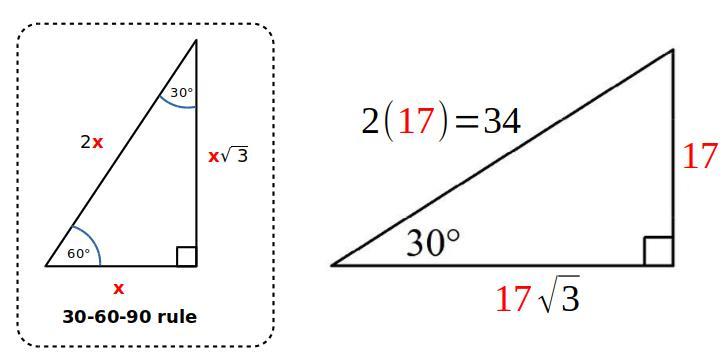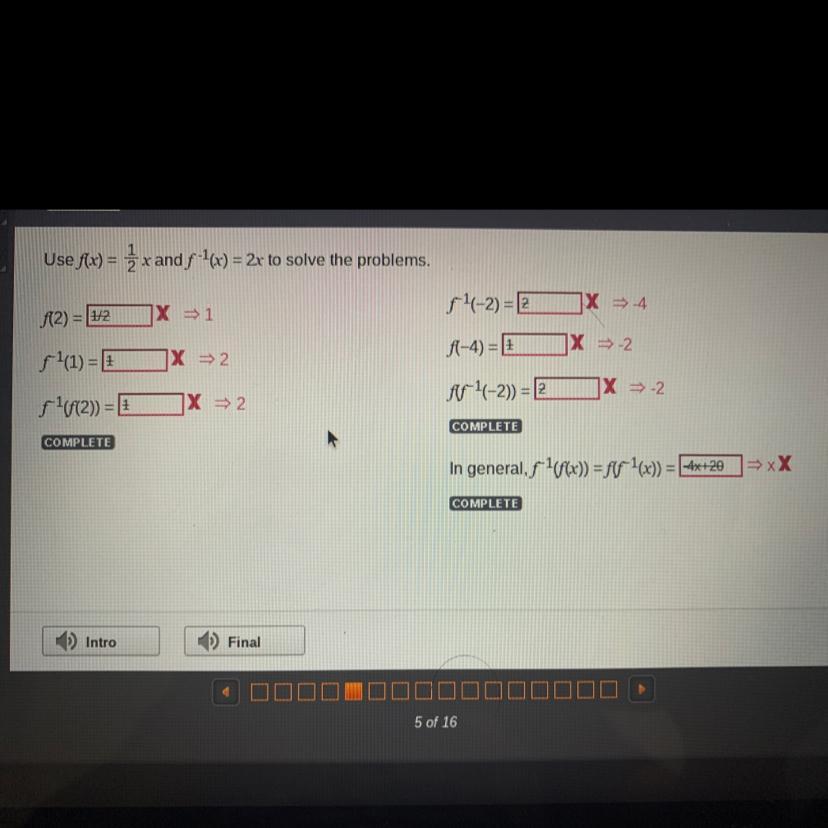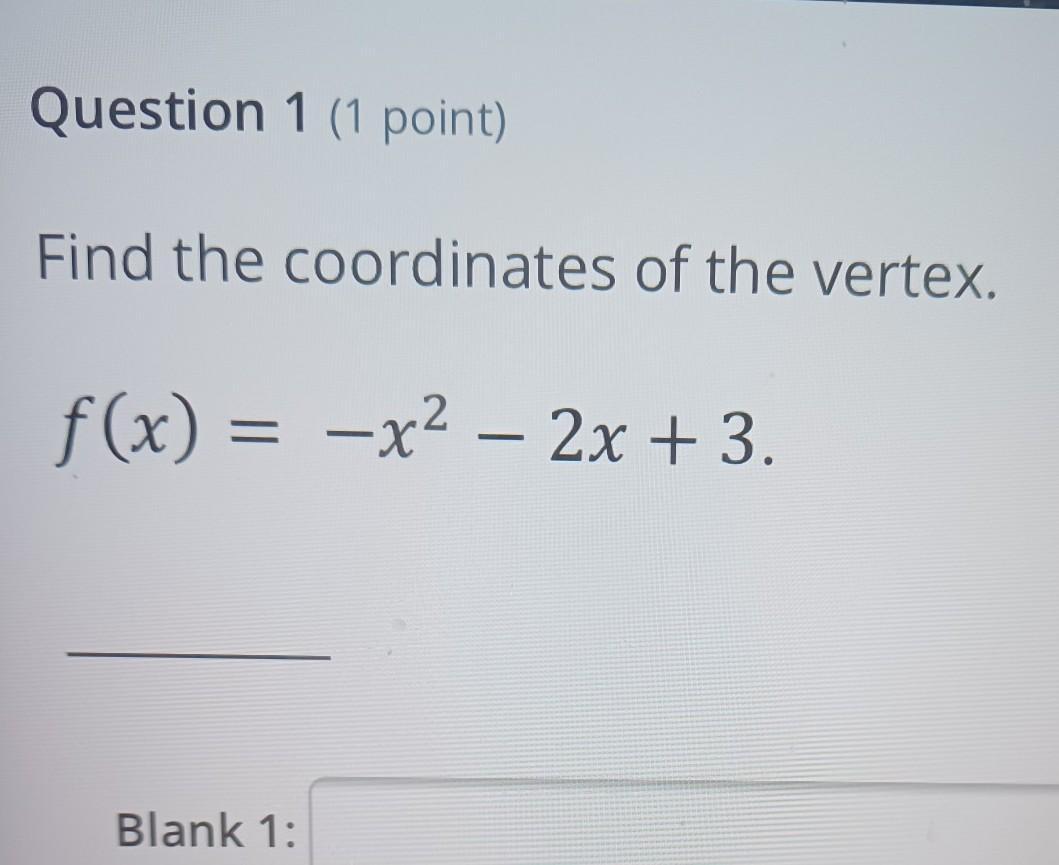The sum of two numbers is 27. One of the numbers is three more than the other. Find the numbers. A) 20 and 7 B) 12 and 15 C) 13 and 14 D) -12 and -15
Answers
Answer:
A
Step-by-step explanation:
Related Questions
Can you solve this equation please? And please explain every step, STEP BY STEP (THIS IS MY HOMEWORK)

Answers
multiply through the equation by 7
x - 14 = x
collect like term
x - x = 14
But 0 is not equal to 14
so, this implies that there is no solution
The correct option is c.
What is the midpoint between the following two points
(3,-2) & (9,2)
A) (6,0)
B) (0,6)
C) (3,1)
D) (3,2)
Answers
Answer:
B, (6,0)
Take the average of the x values and the average of the y values:
(3+9)/2 = 6
(-2+2)/2 = 0
This means the answer (the average (midpoint) of the two points) is (6,0)
1.What is the equation of a circle with center (-2, 2) and radius 3?
Answers
Answer:
(x + 2)² + (y - 2)² = 3²
Step-by-step explanation:
Equation of a circle is (x - a)² + (y - b)² = r²,
where a is the x-coordinate of the centre of the circle, b is the y-coordinate of the centre of the circle, r is the circle's radius.
So, we have (x - -2)² + (y - 2)² = 3²
subtract a minus means we add.
(x + 2)² + (y - 2)² = 3²
What is the answer help

Answers
Answer: 162°
Step-by-step explanation:
To find the answer to this question, we need to find what 45% of 360 degrees (a circle) is.
First, a percent divided by 100 becomes a decimal.
45% / 100 = 0.45
Next, "of" means multiplication in mathematics.
0.45 * 360 = 162
The central angle will be 162°.
2. The following triangle is an isosceles triangle. What is the length of the missing side? ? 11 in. 37 ? 4 in. 11 in 37° 4 in 530
Answers
An ISOSCELES triangle has two sides equal, and two base angles are also equal.
The two sides on the left and the right are equal. The right side measures 11 inches, therefore the left side also measures 11 inches.
The correct answer option is 11 inches
3/8 + 2/3 as a mixed number
Answers
We can convert 3/8 to have a denominator of 24 by multiplying the numerator and denominator by 3:
3/8 = (3 x 3) / (8 x 3) = 9/24
We can convert 2/3 to have a denominator of 24 by multiplying the numerator and denominator by 8:
2/3 = (2 x 8) / (3 x 8) = 16/24
Now we can add the two fractions:
9/24 + 16/24 = 25/24
So the sum of the fractions is 25/24.
To convert this improper fraction to a mixed number, we need to divide the numerator by the denominator:
25 ÷ 24 = 1 with a remainder of 1
The whole number is 1 and the remainder is 1 out of 24. So the mixed number is:
1 1/24
Therefore, 3/8 + 2/3 as a mixed number is 1 1/24.
Answer??????????????

Answers
Answer: 4/5 * 7^1/2 ==> 1st option
Step-by-step explanation:
3(7/25)^1/2-(28/25)^1/2+(63/25)^1/2=
3(7)^1/2 / 5 -(4*7)^1/2 / 5 +(9*7)^1/2 / 5=
3(7)^1/2 / 5 -2(7)^1/2 / 5 +3(7)^1/2 / 5=
(3-2+3)(7^1/2 / 5)=
4(7^1/2 / 5)=4/5 * 7^1/2 ==> 1st option
Evaluate The Integral.(Sec2(T) I + T(T2 +1)4 J + T6 Ln(T) K) Dt
Answers
The Integral \(\int \sec ^2\left(t\right)i+t\left(t^2+1\right)^4j+t^6\ln \left(t\right)kdt = i\tan \left(t\right)+\frac{j\left(t^2+1\right)^5}{10}+k\left(\frac{1}{7}t^7\ln \left(t\right)-\frac{t^7}{49}\right)\)
Given integral;
\(\int \sec ^2\left(t\right)i+t\left(t^2+1\right)^4j+t^6\ln \left(t\right)kdt\)
By solving the above integral, we have;
⇒ \(\int \sec ^2\left(t\right)i+t\left(t^2+1\right)^4j+t^6\ln \left(t\right)kdt\)
By applying the sum rule,
⇒ \(\int f\left(x\right)\pm g\left(x\right)dx=\int f\left(x\right)dx\pm \int g\left(x\right)dx\)
\(=\int \sec ^2\left(t\right)idt+\int \:t\left(t^2+1\right)^4jdt+\int \:t^6\ln \left(t\right)kdt\)
\(\int \sec ^2\left(t\right)idt=i\tan \left(t\right)\)
\(\int \:t\left(t^2+1\right)^4jdt = \frac{j\left(t^2+1\right)^5}{10}\)
\(\int \:t^6\ln \left(t\right)kdt = k\left(\frac{1}{7}t^7\ln \left(t\right)-\frac{t^7}{49}\right)\)
⇒ \(i\tan \left(t\right)+\frac{j\left(t^2+1\right)^5}{10}+k\left(\frac{1}{7}t^7\ln \left(t\right)-\frac{t^7}{49}\right)\)
Therefore, the integral \(\int \sec ^2\left(t\right)i+t\left(t^2+1\right)^4j+t^6\ln \left(t\right)kdt = i\tan \left(t\right)+\frac{j\left(t^2+1\right)^5}{10}+k\left(\frac{1}{7}t^7\ln \left(t\right)-\frac{t^7}{49}\right)\)
To learn more about Integral click here:
brainly.com/question/18125359
#SPJ4
6. A trail is 13.5 miles long. There are markers every 0.25 mile along the trail, including at the
end of the trail. How many markers are there in all?
a) 4
b) 5
c) 40
d) 54
Answers
Answer:
54
Step-by-step explanation:
13.5/0.25=54
Help please & fast!! Due Tonight at 11:30 Aubrey is saving up to buy a new jacket. She already has $85 and can save an additional $7 per week using money from her after school job. How much total money would Aubrey have after 8 weeks of saving? Also, write an expression that represents the amount of money Aubrey would have saved in ww weeks.
Answers
Hey there! I'm happy to help!
We'll call our weeks w and call our total savings s.
We have an initial $85 and then we add 7 every week. This means that we will be adding 7 for every week, so we will put this in our equation as 7w.
Therefore, our equation would be s=7w+85
Now, we plug in 8 for our w value to see how much money she will have after 8 weeks.
s=7(8)+85
s=56+85
s=141
Therefore, Aubrey will have saved $141 after 8 weeks.
I hope that this helps! Have a wonderful day! :D
1) The Pet Company has recently discovered a type of rock which, when crushed, is extremely absorbent. It is expected that the firm will experience (beginning now) an unusually high growth rate (20%) during the period (3 years) when it has exclusive rights to the property where this rock can be found. However, beginning with the fourth year the firm's competition will have access to the material, and from that time on the firm will assume a normal growth rate of 8% annually. During the rapid growth period, the firm's dividend payout ratio will be relatively low (20%), to conserve funds for reinvestment. However, the decrease in growth will be accompanied by an increase in dividend payout to 50%. Last year's earnings were $2.00 per share (E0) and the firm's cost of equity is 10%. What should be the current price of the common stock?
Answers
Answer:
$ 71.83
Step-by-step explanation:
This year's earnings=last year's earnings*(1+growth rate)=$2*(1+20%)=$2.4
This year's dividend=2.4 *payout ratio=2.4 *20%=$0.48
Next year's earnings=$2.4*1.2=$2.88
Next year's dividend=2.88 *0.2=$ 0.58
Year 3 earnings=$2.88*1.2=$ 3.46
Year three dividend= 3.46*0.2=$0.69
year 4 earnings =$3.46*1.08=$ 3.74
Dividend from year 4 onward= 3.74 *0.5=1.87
From year 4 terminal value=1.87 /(cost of equity-growth rate)=1.87/(10%-8%)=$93.5
Share price is present value of the above dividends amnd terminal value=0.48/(1+0.1)^0+0.58/(1+0.1)^1+0.69/(1+0.1)^2+93.5/(1+0.1)^3=$ 71.83
How to do this question

Answers
Answer:
the answer is 21
Step-by-step explanation:
first you need to find which function that -5 belongs in.
you will see that you need to plug -5 into the first equation -4x+1
-4(-5)+1=21
Label the triangle sides, assuming the angle of interest is the 30-degree angle:
solve for
The side with x is the
blank side.
The side with y is the
NO SPAM I WILL REPORT YOU
blank side.
The side with 17 is the blank side

Answers
Check the picture below.

In a math class, the teacher asked the students to find the approximate value of one of the x-coordinates of a point of intersection of two functions: f(x) = 2x2 − 3x + 4 g(x) = 5x − 1 Her students gave her different answers. Which answer is the most accurate?
A.
0.8
B.
0.9
C.
1.9
D.
1.1
Answers
Answer:
A. 0.8Step-by-step explanation:
An easy way is to substitute values into both equations and compare:
A. x = 0.8
f(x) = 2(0.8)² - 3(0.8) + 4 = 2.88g(x) = 5(0.8) - 1 = 3B. x = 0.9
f(x) = 2(0.9)² - 3(0.9) + 4 = 2.92g(x) = 5(0.9) - 1 = 3.5C. x = 1.9
f(x) = 2(1.9)² - 3(1.9) + 4 = 5.52g(x) = 5(1.9) - 1 = 8.5D. x = 1.1
f(x) = 2(1.1)² - 3(1.1) + 4 = 3.12g(x) = 5(1.1) - 1 = 4.5As we see the most accurate one is A
Let's graph both function(Attached)
Let's round 0.775
\(\\ \sf\longmapsto 0.775\)
\(\\ \sf\longmapsto 0.77\)
\(\\ \sf\longmapsto 0.8\)
Option A is correct

Don’t know how to solve with the -1 before the x

Answers
ANSWER and EXPLANATION
We are given a function and its inverse function:
\(\begin{gathered} f(x)=\frac{1}{2}x \\ f^{-1}(x)=2x \end{gathered}\)To solve the problems, we have to substitute the values of x in the brackets into the appropriate function (or inverse function).
Therefore, we have that the value of the function for x = 2:
\(\begin{gathered} f(2)=\frac{1}{2}\cdot2 \\ f(2)=1 \end{gathered}\)For x = 1, we have that the value of the inverse function is:
\(\begin{gathered} f^{-1}(1)=2(1) \\ f^{-1}(1)=2 \end{gathered}\)For x = -2, we have that the value of the inverse function is:
\(\begin{gathered} f^{-1}(-2)=2\cdot-2 \\ f^{-1}(-2)=-4 \end{gathered}\)For x = -4, we have that the value of the function is:
\(\begin{gathered} f(-4)=\frac{1}{2}\cdot-4 \\ f(-4)=-2 \end{gathered}\)For the fifth option, substitute the value of the function at x = 2 into the inverse function.
That is:
\(\begin{gathered} f^{-1}(f(2))=f^{-1}(1)=2\cdot1 \\ f^{-1}(f(2))=2 \end{gathered}\)For the sixth option, substitute the value of the inverse function at x = -2 into the function.
That is:
\(\begin{gathered} f(f^{-1}(-2))=f(-4)=\frac{1}{2}\cdot-4 \\ f(f^{-1}(-2))=-2 \end{gathered}\)To find the general form of the function:
\(f^{-1}(f(x))=f(f^{-1}(x))\)either substitute the function for x in the inverse function or substitute the inverse function for x in the function.
Therefore:
\(\begin{gathered} f^{-1}(f(x))=2(\frac{1}{2}x)) \\ f^{-1}(f(x))=x \end{gathered}\)That is the answer.
please work QUICK its a test

Answers
Which function represents the inverse of function f?
= 3x + 5
O A. T (2)
O B.
O c.
O D.
=-3x - 5
x+ //
– ž
g(x) =
p(x) =
8(x) = 3z +5
x

Answers
The inverse function of f(x) = 3x + 5 is given as follows:
C. p(x) = 1/3x - 5/3.
How to obtain the inverse function?The function in the context of this problem is defined as follows:
f(x) = 3x + 5.
To obtain the inverse function, first we must exchange the variables x and y, hence:
y = 3x + 5
x = 3y + 5.
Now we must isolate the variable y, hence:
3y = x - 5
y = (x - 5)/3.
p(x) = 1/3x - 5/3.
More can be learned about inverse functions at https://brainly.com/question/3831584
#SPJ1
In triangle DEF, EF = 4cm, DF = 7cm, Find angle D
And E is the right angle
Answers
Hello !
1. The triangleD
I\
I \
I \
I \ 7cm
I \
I \
I \
E 4cm F
2. Find the ratio of the angle DThe ratio = hypotenuse ; opposite
⇒ calculate sin(D)
3. Calculate the angle Dsin(D) = opposite/hypotenuse = 4/7
arcsin(4/7) ≈ 34,84.. ≈ 35°
4. ConclusionThe angle D measures 35°.
Compute the amount of interest earned in the following simple interest problem. A deposit of $4,500 at 5% for 3 years:
$67.50
$6.75
$675.00
$6,750.00
Answers
Answer:
$675.00
Step-by-step explanation:
4500 x 0.05 x 3 = 675
which equation is equivalent to 2x + 4a = 10
Answers
Subtract 4a
2x = 10 - 4a
Divide by 2
x = 5 - 2
The answer is x = 5-2a
Answer:
x = 5 - 2a
Step by step explanation:
2x + 4a = 10
So, 2x = 10 - 4a
=> x = (10 - 4a)/2
=> x = 5 - 2a
Hope this answer helps, if it does help, please mark me as brainliest,
Thank you.
cuál sería la excepción de 41 ??
Answers
Aquí, queremos escribir ecuaciones donde el resultado de la variable es el número 41;
\(x\text{ + 2 = 43}\)El valor de x en la ecuación anterior es 41
Escribamos una segunda ecuación;
\(2y\text{ = 82}\)El valor de 'y' aquí también es 41
Which percent is equivalent to 2 5/6?
Answers
Answer: 283.3333333% (283.3%)
Step-by-step explanation:
First, lets turn 2 5/6 into and improper fraction. It becomes 17/6.
Now, we divide 17/6
17/6 = 2.833333333
Now, to turn it into a percent, we multiply it by 100, or move the decimal point 2 places to the right. That gives us 283.3333333% (283.3%)
Hope this helps!
Find angles m<1 and m<2

Answers
Answer:
Step-by-step explanation:Angles 1 and 2 form a linear pair and are supplementary. So to find m∠2, subtract m∠1 from 180o. m∠2 = 180o - 135o = 45o.
...
Solution
m∠1 + 32 = 90 Substitute 32 for m∠2.
m∠1 = 58 Subtract 32 from each side.
m∠1 + m∠ 2 = 90 Definition of complementary angles.
How do your write a feaction with a denominator of 20 as a decimal?
Answers
Answer:
Step-by-step explanation:
What is 20 as a decimal? To write 20 as a decimal you have to divide numerator by the denominator of the fraction. 20 is not a fraction so it is a decimal already. And finally we have: 20 as a decimal equals 20
What is the value of n 8n-5=139
Answers
The value of 'n' is 18 in the given equation 8n - 5 = 139.
We have to find the value of 'n'.
To do so, we need to solve the given equation.
Let us see how we can solve the given equation.8n - 5 = 139
We need to find the value of 'n'.
Let us bring the constant term to the right side by adding 5 to both the sides of the equation.8n - 5 + 5 = 139 + 5On simplifying, we get8n = 144Now, we need to isolate 'n' to find its value.
To do so, we divide both the sides by 8.8n/8 = 144/8On simplifying, we get n = 18
Therefore, the value of 'n' is 18.
Hence, the value of 'n' is 18 in the given equation 8n - 5 = 139.
For more questions on equation
https://brainly.com/question/17145398
#SPJ8
find the coordinates of the vertex

Answers
You can either transform this quadratic equation into a vertex form which would rather painful or use derivatives.
I'll use dervatives. We know that vertex of a quadratic function is either its maxima or its minima, since the leading coefficient \(-x^2\) has a negative prefix that means we get a downward turned parabola with minima being the vertex.
First we take the derivative with respect to x,
\(\dfrac{d}{dx}-x^2-2x+3=-2x-2\)
The derivative is esentially information what is the slope of a function at a particular x. When the slope is 0 we reached some sort of turning point, such as minima.
We therefore do,
\(-2x-2=0\implies x=-1\)
So at \(x=-1\) there appears to be a minima or x-coordinate of the vertex of the function.
Plug the coordinate into the function to get y,
\(y=f(-1)=-1+2+3=4\)
So the vertex of the function is at \(\boxed{(-1,4)}\).
Assuming you don't know derivatives, there is another way.
First compute the roots of the function,
\(-x^2-2x+3=0\)
\(-(x-1)(x+3)=0\)
\(x_1=1,x_2=-3\)
In the middle between \(x_1,x_2\) is an x coordinate of a vertex,
\(x=\dfrac{x_1+x_2}{2}=\dfrac{1-3}{2}=-1\)
Just like we had before, we compute for y, \(h(-1)=4\) and again the result is \(\boxed{(-1,4)}\).
Hope this helps :)
Find z within the problem.

Answers
Answer:
z = √35
Step-by-step explanation:
In this geometry, all of the right triangles are similar, so corresponding sides are proportional.
long side / hypotenuse = 5/z = z/(2+5)
z² = 5(7) = 35
z = √35
Yolanda used her graphing calculator to graph y= 3x. Her graph is shown at right. Do you think she
did it correctly? Explain.

Answers
A cereal box is shaped like a rectangular prism. The box is 20 cm long by 5 cm wide by 30 cm high. What is the surface area of the cereal box?
Answers
The front and back would be ; (length x height) x 2
So;
(20 x 30) x 2
= 1200 cm^2
Then calculate the area of the top and bottom of the box;
(Width x Length)
(5 x 20) x 2
= (100) x 2
= 200 cm ^2
And finally the sides of the box:
(Width x Height) x 2
(5 x 30) x 2
= 300 cm^2
Now add all of the individual areas up to find the total surface area of the cereal box:
1200 + 200 + 30
= 1700cm^2 in total
Have to make the equation on the left look like the equation on the right. There are apparently only 2 steps but I can not figure it out for myself. Also not supposed to touch the second equation just show how you get it from the first.

Answers
Step-by-step explanation:
\( \frac{a}{b} c = \frac{a}{ \frac{b}{c} } \)
\( \frac{a}{b} c = a \times \frac{c}{b} \)
Answer:
Step-by-step explanation: change A/B/C to A÷B/C then change the division sign into a multiplicmultiplication sign so that you will have A×C/Bwhich will make your left equation = to your right equation